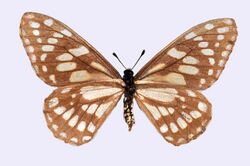Biology:Baronia
| Baronia | |
|---|---|

| |
| Scientific classification | |
| Domain: | Eukaryota |
| Kingdom: | Animalia |
| Phylum: | Arthropoda |
| Class: | Insecta |
| Order: | Lepidoptera |
| Family: | Papilionidae |
| Subfamily: | Baroniinae Bryk, 1913 |
| Genus: | Baronia Salvin, 1893 |
| Species: | B. brevicornis
|
| Binomial name | |
| Baronia brevicornis Salvin, 1893
| |
Baronia brevicornis, commonly known as the short-horned baronia, is a species of butterfly in the monotypic genus Baronia and is placed in a subfamily of its own, the Baroniinae, a sister group of the remainder of the swallowtail butterflies.[2] It is endemic to a very small area of Mexico, where the distribution is patchy and restricted.[3][4]
The genus is named after Oscar Theodor Baron who collected the first specimen in the Sierra Madre region of Mexico.[5] The species was then described by Salvin.[6]
Morphological characteristics include an abdominal scent organ in females.[7][8]
Baronia is unique among swallowtail butterflies or their relatives in having an Acacia species, Vachellia campeachiana (synonym Acacia cochliacantha, family Leguminosae) as its larval food plant.[9][10]
Taxonomy
Baronia brevicornis is of particular importance due to its relict nature and uncertain relationship to other subfamilies such as the Parnassiinae. It is now considered to represent the monotypic subfamily Baroniinae. The butterfly was considered as the most primitive extant papilionid taxon and shares some features with the fossil genus Praepapilio, and a comprehensive 2018 molecular phylogeny suggests that they are the sister group of the remainder of the Papilionidae.[11]
Subspecies
- B. b. brevicornis
- B. b. rufodiscalis
References
- ↑ Puttick, A.; Leon-Cortes, J.; Legal, L. (2018). "Baronia brevicornis". IUCN Red List of Threatened Species 2018: e.T2594A119581233. doi:10.2305/IUCN.UK.2018-2.RLTS.T2594A119581233.en. https://www.iucnredlist.org/species/2594/119581233. Retrieved 17 November 2021.
- ↑ "BARONIA - Butterflies and Moths of the World". http://nhm.ac.uk/our-science/data/butmoth/search/GenusDetails.dsml?NUMBER=3613.0&. Retrieved 6 December 2016.
- ↑ Luis-Martinez, A.; J. Llorente-Bousquets; Isable Vargas-Fernandez; A. D. Warren (2003). "Biodiversity and biogeography of Mexican butterflies (Lepidoptera: Papilionoidea and Hesperioidea)". Proceedings of the Entomological Society of Washington 105 (1): 209–224. Archived from the original on 20 September 2009. https://web.archive.org/web/20090920054109/http://www.mariposasmexicanas.com/docs/Papilionoidea-Hesperioidea_Biodiversity-Biogeography.pdf.
- ↑ Llorente-Bousquets, J & A. Luis-Martinez (1993) Conservation-oriented analysis of Mexican butterflies: Papilionidae (Lepidoptera, Papilionoidea). In Ramammorthy, T.P., J. Fa, R. Bye y A. Lot (Eds.). 1993. The biological diversity of Mexico: origins and distributions. Oxford University Press. PDF
- ↑ Boullet, Eugène (1913). "Description d'une forme femelle de Baronia brevicornis Godm. et Salv. [Lep. Papilionidae"]. Bulletin de la Société entomologique de France 18 (3): 99–101. doi:10.3406/bsef.1913.25260. https://www.persee.fr/doc/bsef_0037-928x_1913_num_18_3_25260.
- ↑ Digital collection sil.si.edu
- ↑ Robbins, Robert K. (1989). "Systematic implications of butterfly leg structures that clean the antennae". Psyche 96 (3–4): 209–222. doi:10.1155/1989/43420.
- ↑ Häuser, C. L. (1992). "A new abdominal scent organ in females of Baronia brevicornis (Lepidoptera: Papilionidae)". Zoologischer Anzeiger 229 (1/2): 54–62.
- ↑ Collins, N. Mark; Morris, Michael G. (1985). Threatened Swallowtail Butterflies of the World: The IUCN Red Data Book. Gland & Cambridge: IUCN. ISBN 978-2-88032-603-6. https://www.biodiversitylibrary.org/item/98674#page/7/mode/1up.
- ↑ Savela, Markku (16 February 2008). "Baronia". Lepidoptera and some other life forms. nic.funet.fi. http://www.nic.funet.fi/index/Tree_of_life/insecta/lepidoptera/ditrysia/papilionoidea/papilionidae/baroniinae/baronia/index.html. Retrieved 9 November 2010.
- ↑ Espeland, Marianne; Breinholt, Jesse; Willmott, Keith R.; Warren, Andrew D.; Vila, Roger; Toussaint, Emmanuel F.A.; Maunsell, Sarah C.; Aduse-Poku, Kwaku et al. (2018). "A Comprehensive and Dated Phylogenomic Analysis of Butterflies". Current Biology 28 (5): 770–778.e5. doi:10.1016/j.cub.2018.01.061. PMID 29456146.
Illustrated works:
- Edwin Möhn, 2002 Schmetterlinge der Erde, Butterflies of the world Part XIIII (14), Papilionidae VIII: Baronia, Euryades, Protographium, Neographium, Eurytides. Edited by Erich Bauer and Thomas Frankenbach Keltern: Goecke & Evers; Canterbury: Hillside Books. ISBN:978-3-931374-87-7 All species and subspecies are included, also most of the forms. Several females are shown the first time in colour.
- Lewis, H. L., 1974 Butterflies of the World ISBN:0-245-52097-X Page 23, figure 6, female.
External links
| Wikimedia Commons has media related to Baronia. |
- Pteron Undersides on right.
- Images
- Markku Savela's website
- BOA Photographs of type specimens including types of subspecies
Wikidata ☰ {{{from}}} entry
 |


